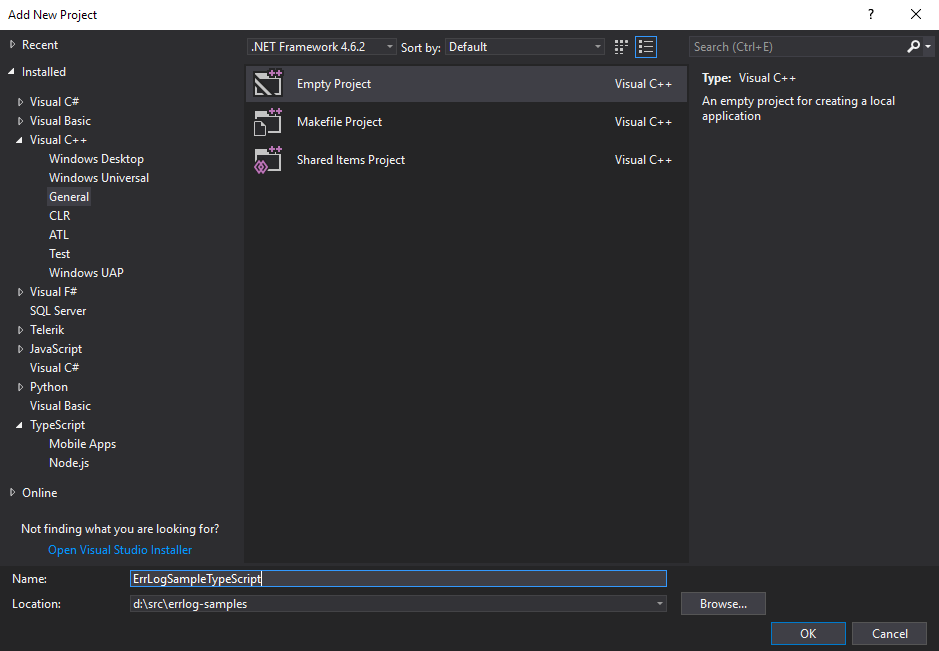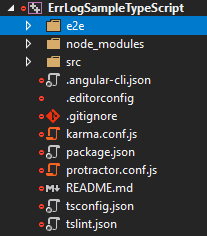We don't currently have a custom package available, however you can use our
generic api at
https://relay.errlog.io/api/v1/log
to provide your own logging mechanism to your ErrLog.IO
account.
For a look at the fields you can include with your API calls check out
Payload
Variables
Important Note: These example use Angular libraries to simplify sending HTTP messages - you can use other frameworks if desired.
There are many different modules and frameworks for TypeScript and each will have their own way of dealing with web requests. This example uses Angular, however the method used will be the same: catch an exception (or create your own data packet) and send it to ErrLog.IO.
The example below uses the following package -
HttpClientModule module from Angular to make the POST request to ErrLog.IO.
To install and run the project I'll be using the
Angular CLI so it will need to be installed using:
npm install -g @angular/cli
In this example we use the AppModule constructor to do all the hard work, purely for simplicity. It would be better to isolate the error logging functionality into a separate class.
import ("net/http"
"fmt"
"bytes"
"io/ioutil"
);
To include the files in the solution, we created a generic C++ project in Visual Studio. This was because it was a minimalist project type and it won't be compiled from within Visual Studio.

Then from the folder where your newly created project is hosted run ng new [project_name] to create the project files. This will take a minute or two.

You will also need to install some npm packages:
npm i –D @angular/core @angular/http @angular/platform-browser @angular/core @angular/common zone.js rxjs
Your project should now look like this:

You'll need to have the following lines in your tsconfig.json file.
"lib": [
"es2017",
"dom"
],
"types": [ "node" ],
Your app.module.ts file will need to look like this (for the includes and imports):
import { BrowserModule } from '@angular/platform-browser';
import { NgModule } from '@angular/core';
import { HttpClientModule } from '@angular/common/http';
import { AppComponent } from './app.component';
@NgModule({
declarations: [
AppComponent
],
imports: [
BrowserModule,
HttpClientModule
],
providers: [],
bootstrap: [AppComponent]
})
export class AppModule { }
This is the code that gets run when the homepage is loaded. There are a few parts to it and we will break them down here for you.
These make sure all the necessary functionality is available.
import { Component } from '@angular/core';
import { HttpModule, Http } from '@angular/http';
import { BrowserModule } from '@angular/platform-browser';
import { NgModule, ErrorHandler } from '@angular/core';
import { HttpClientModule, HttpClient, HttpHeaders, HttpResponse } from '@angular/common/http';
Adding
HttpModule to the
@NgModule decorator allows us to use
http later on.
See
@NgModule for more information.
@NgModule({
imports: [
BrowserModule,
HttpModule,
],
declarations: [AppComponent],
bootstrap: [AppComponent]
})
Similar to other examples, we set up a data packet that contains the data we want to send to ErrLog.IO. As we're not handling a native exception, the data here is arbitrary but it shows the way it can be used.
If you have an exception object or other data you want to use, the data here can be easily swapped out for the appropriate variables. For more information about what can be included in the data packet, see
Payload Variables.
const data = {
apikey: '[Your-api-key]',
message: 'This is a test message from TYPESCRIPT!!!',
applicationname: 'TypeScript Application',
type: 'TypeScript Exception',
errordate: new Date().toISOString(),
trace: 'ex.StackTrace',
filename: 'app.component.ts',
method: 'constructor',
lineno: 123,
colno: 456
};
You can also set the API endpoint and headers here as well if you like:
const url = 'https://relay.errlog.io/api/v1/log';
const headers = new HttpHeaders({ 'Content-Type': 'application/json; charset=utf-8' });
This performs the POST request to the API endpoint. You can do what you like with the response.
In this example we just console.log(..) it for debugging purposes.
const req = http.post(url, data, { headers })
.subscribe(
(res) => {
console.log('Response: ' + res);
},
err => {
console.log('Error occured');
},
() => {
console.log('The POST observable is now completed.');
}
);
From the root of your project, run ng serve to start the web application.

From there you just need to browse to the specified URL, in this case: http://localhost:4200/
After successfully logging an error, you will receive a HTTP 200 response from the web request and your exception will have been logged to your ErrLog.IO
dashboard.